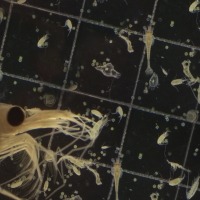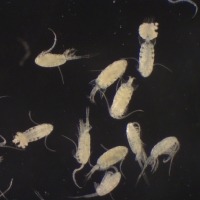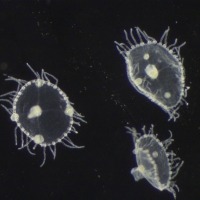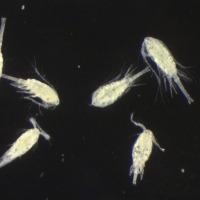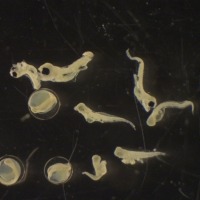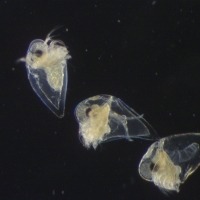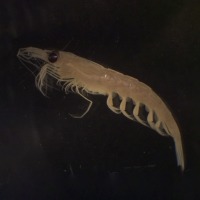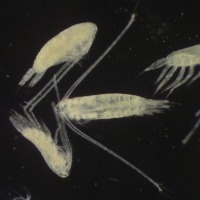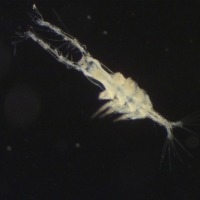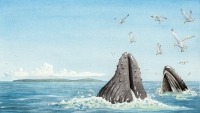
Head Harbour Passage
to the Wolves
Dive Deeper
On the outer fringes of the Quoddy Region, tides and seabed shape combine to create upwellings. These concentrate the tiny plants and animals that make up the plankton and push them up to the sea surface. Many species congregate here to feed on this bounty. You can see flocks of birds diving down to snatch prey from the sea surface. Humpback whales loom up from the depths, scooping up the krill and herring in their vast mouths. Right whales also visit to feed. Scientists study these endangered animals to help conserve them.

North Atlantic Right Whale
Eubalaena glacialis
Right whales come to Atlantic Canada to feed. Their main prey are tiny planktonic crustaceans. They swim through the dense plankton patches found in this region, taking large volumes of water into their mouths. They then filter the water out through their baleen plates, trapping prey on the plate's hair-like fringes. Right whales can reach 18 metres in length and live for over 70 years. Each whale has a unique pattern of rough skin called callosities on their head. These let us identify individual whales. The North Atlantic right whale is one of the most endangered mammals in the world with only 400 to 450 individuals remaining. Vessel strikes and entanglement in fishing gear can kill or injure them. People are working hard to find ways to protect them.
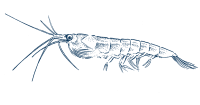
Nordic Krill
Meganyctiphanes norvegica
Adult krill are only 22 to 45 millimetres in length. These shrimp-like crustaceans have five pairs of swimming legs and two large red eyes. Both the adults and larvae are zooplankton (animal plankton), swimming in the seawater column. They undertake daily vertical migrations, spending the daytime deeper than in the nighttime. They are found as deep as 500 metres. This species is an important component of the zooplankton in this area and provides food for whales, fish, and birds. It sometimes forms red swarms at the sea surface that attract abundant aerial and aquatic predators. Densities in these swarms can be as much as 770 000 krill (or 154 kilograms of krill) per cubed metre of seawater.
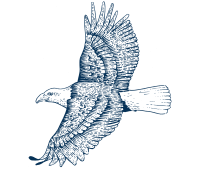
Bald Eagle
Haliaeetus leucocephalus
This large brown and white bird can have a wingspan of up to 2.4 metres. The eagle isn't featherless on its head - bald also means "marked with white" and refers to its colouring. It is common in this region where it nests in forested areas near the water. It uses its strong talons to capture fish such as salmon and herring. It sometimes steals fish from other birds. Eagles mate for life and usually return to the same nest site each year. Males and females work together to build large nests out of sticks in conifer trees. Both parents care for their chicks, bringing them food and tearing off small pieces for them. Adults can live for up to 28 years.
3D Exploration
Head Harbour Passage
Come whale watching in Head Harbour Passage! Take a virtual boat trip using our interactive 3D map. The seabed has been mapped using sound waves (sonar). Let images and videos introduce you to the whales, birds, and other species that visit here.
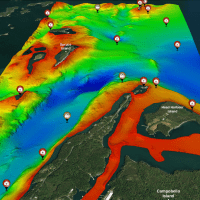
The Wolves
Come whale watching at the Wolves Archipelago, on the outermost fringes of the Quoddy Region! Take a virtual boat trip using our interactive 3D map. The seabed has been mapped using sound waves (sonar). See oceanic species such as the endangered right whale. Learn how scientists study whales and the tiny creatures they feed on.

Interactive Microscope
Plankton is a term for small marine organisms that are unable to swim against ocean currents and are therefore carried with them. Some species live their whole lives as plankton and many organisms have a planktonic larval phase. Plankton form the bottom of the marine food chain and are important in the diet of larger species such as birds, fish, and whales. Most plankton are small, so to identify and study them we need to look down the microscope.

Marine Career
Marine Mammal Scientist
Moira Brown is a scientist with the Candian Whale Institute. She studies North Atlantic right whales. She works with other researchers, industry and government to find ways to protect this endangered species.
Learn moreTechnology
Right Whale Tracking
Right whales have unique markings that we can use to identify individuals from photos. Scientists have used this technique for many decades to study right whales. We can track right whale births and movements. We can also study associations, life history, age, sex, and serious injury and scarring.
Learn more

